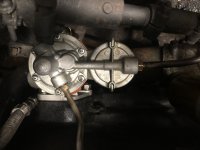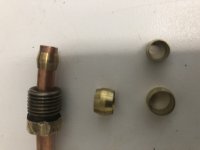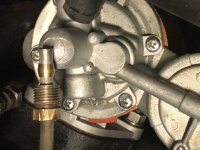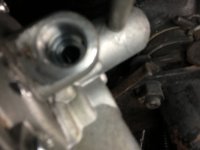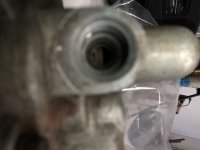-
 Hi Guest!
Hi Guest!
If you appreciate British Car Forum and our 25 years of supporting British car enthusiasts with technical and anicdotal information, collected from our thousands of great members, please support us with a low-cost subscription. You can become a supporting member for less than the dues of most car clubs.
There are some perks with a member upgrade!**Upgrade Now**
(PS: Subscribers don't see this gawd-aweful banner

Tips
- We have a special forum called "Member Articles" where you can submit actual articles for consideration for publication. Learn More
- Don't have an Avatar? If not, your avatar will default to the 1st character in your username. Go into "Account Details" to change your Avatar.
- Some basic forum navigation info: click
Hey - did you know if you click on the title of a thread it will take you to the first unread post since you last visited that thread?
- Hey Guest - Is your British Car Club in our Clubs database? If not, send me a PM - Basil

- Looking for a local club? Click the "Clubs" tab above and browse hundreds of clubs world-wide.
- Add Android or iPhone APP: click
- Did you know - any picture or video you add in your posts in any marque-specific forum will also get added to the Media Gallery automatically.
- A few more tips about posting and replying: click
- Hey there Guest - be sure to keep your profile page up to date with interesting info about yourself: learn more
- More tips and tricks on Posting and Replying: click
 STOP!! Never post your email address in open forums. Bots can "harvest" your email! If you must share your email use a Private Message or use the
STOP!! Never post your email address in open forums. Bots can "harvest" your email! If you must share your email use a Private Message or use the  smilie in place of the real @
smilie in place of the real @
- Want to mention another member in a post & get their attention? WATCH THIS

- So, you created a "Group" here at BCF and would like to invite other members to join? Watch this!
- Hey Guest - A post a day keeps Basil from visiting you in the small hours and putting a bat up your nightdress!
- Hey Guest - do you know of an upcoming British car event?
 Pretty Please - add it to our Events forum(s) and add to the calendar! >> Here's How <<
Pretty Please - add it to our Events forum(s) and add to the calendar! >> Here's How << 
- Hey Guest - you be stylin'
Change the look and feel of the forum to fit your taste. Check it out
- If you run across an inappropriate post, for example a post that breaks our rules or looks like it might be spam, you can report the post to the moderators: Learn More
- If you would like to try some different "looks" or styles for the site, scroll to the very bottom, on the left and click the Style Selector.
You are using an out of date browser. It may not display this or other websites correctly.
You should upgrade or use an alternative browser.
You should upgrade or use an alternative browser.
59 TR3A Fuel Pump
- Thread starter Donald1107
- Start date
Donald1107
Senior Member
Offline
It does not have the gasoline line shutoff valve.
Offline
MD,
The difference between lower end gasoline hose and fuel injection rated hose is pressure. The TR3 runs on a 5 or 6 pounds of fuel pressure. Fuel injected cars run at ten times that. The fuel injection rating says nothing about resistance to alcohol, heat resistance or permeability. I see nothing wrong with using SAE 30 R 6, 7or14 rated fuel hose on our TR3s. Although nothing wrong with using fuel injection rated hose either, I don't think you gain anything and I don't think people need to change all their hoses.
See this for more:
Fuel hose rating
Tom
The difference between lower end gasoline hose and fuel injection rated hose is pressure. The TR3 runs on a 5 or 6 pounds of fuel pressure. Fuel injected cars run at ten times that. The fuel injection rating says nothing about resistance to alcohol, heat resistance or permeability. I see nothing wrong with using SAE 30 R 6, 7or14 rated fuel hose on our TR3s. Although nothing wrong with using fuel injection rated hose either, I don't think you gain anything and I don't think people need to change all their hoses.
See this for more:
Fuel hose rating
Tom
thanks i will add more fuel and c what happens..im getting fuel to the pump thats it,fuel filter good all lines are good.Your first step might be to confirm that the problem it is a lack of fuel. There are several ways to do this: Looking in the throat of the carbs, spraying starting fluid into the intake, seeing if the spark plugs are wet after cranking, etc.
At the very least confirm you have spark at the plugs.
As I recall, a TR6 fuel pump does not have a glass bowl so there is no opportunity for direct inspection there. It should have a priming lever which can be worked to try to move fuel . You can possibly tell by feel if that lever is really pumping fuel - but only if you have used it in the past and know what that should feel like.
These pumps prime better if there is a lot of gas in the tank - not as well if the tank is low and the level is near the same as the pump. How full is your tank?
For a simple 'what to try?' you might get the tank up to half full if you can then use a bit of starting fluid to get the engine to fire briekly, that may be enough to get a recalcitrant pump to take over.
Of course, you could have a bum part but really these pumps are so simple and nearly fool-proof that a bad new one seems unlikely.
thanks will add more fuelYour first step might be to confirm that the problem it is a lack of fuel. There are several ways to do this: Looking in the throat of the carbs, spraying starting fluid into the intake, seeing if the spark plugs are wet after cranking, etc.
At the very least confirm you have spark at the plugs.
As I recall, a TR6 fuel pump does not have a glass bowl so there is no opportunity for direct inspection there. It should have a priming lever which can be worked to try to move fuel . You can possibly tell by feel if that lever is really pumping fuel - but only if you have used it in the past and know what that should feel like.
These pumps prime better if there is a lot of gas in the tank - not as well if the tank is low and the level is near the same as the pump. How full is your tank?
For a simple 'what to try?' you might get the tank up to half full if you can then use a bit of starting fluid to get the engine to fire briekly, that may be enough to get a recalcitrant pump to take over.
Of course, you could have a bum part but really these pumps are so simple and nearly fool-proof that a bad new one seems unlikely.
Donald1107
Senior Member
Offline
Good news: my latest effort to get the replacement fuel pump to pump gas has been successful. My chemical engineering knowledge was telling me that the pump was vapor locked: won’t pump air when dry. So I connected a large funnel to the pump inlet pipe, and disconnected the hose to the first carburetor, sticking it in a jar. I poured gasoline in the funnel and pumped the priming lever. Almost immediately felt resistance on the priming lever and a few more strokes and gasoline ran out the front carb hose. I slid the hose on the carb inlet nozzle and pumped more gas until it would pump no more (float bowls full). Lowered the hose from the gas tank till gas ran out and hooked that to the pump inlet. While pumping the primer lever, I noted very small gas leaks at the pump inlet and outlet pipe connections and tightened those up. The engine started right up and sustained running longer that what would empty the float bowls. So I deem the problem solved.
Thanks for everyone’s suggestions.
Thanks for everyone’s suggestions.
Donald1107
Senior Member
Offline
Guys: I have my fuel pump problem solved, but potentially not my only engine problem. Have any of you experienced vapor lock in the fuel system? Twice my engine just quit running at about 40 mph and 20 minutes of driving. The engine ran just fine for a half hour idling in the garage; temp gauge never over 140 F. A friend suggested vapor lock, but I don’t see how that can be. I got the engine restarted both times by pouring gas into the carb float chambers, but the fuel pump is definitely working well and the fuel tank is near full (10 gallons). What could cause the engine to quit running while driving 40 mph in 4th gear?
i have a 1972 tr6...i parked my car in garage last fall no problem.fast forward to spring and my car will not start..have spark,put new fuel pump on still will not start...took carburators off cleaned them still will not start sprayed numerous starting fluids in carbs but nothing.fuel lines are not plugged getting gas up to the carbs have plenty of gas in tank.not sure what to do next?
I put brand new fuel pump on 72 triumph tr6...still will not start..fuel is not clogged,?
Geo Hahn
Yoda
Offline
A twofer...
A failing coil can let you down once it gets hot. Then as you futz with the carbs around thinking it is fuel-related it cools down and works again.
Everyone should carry a spare coil - no need to mount it, can be bungeed or taped to the one already there for a quick test. Just move the wres over.
A common failure after a long sit is a nearly closed points gap. Simple to check, just look at the points as you rotate the engine and confirm they open enough.
Could be a lot of other things too.
What could cause the engine to quit running while driving 40 mph in 4th gear?
A failing coil can let you down once it gets hot. Then as you futz with the carbs around thinking it is fuel-related it cools down and works again.
Everyone should carry a spare coil - no need to mount it, can be bungeed or taped to the one already there for a quick test. Just move the wres over.
fast forward to spring and my car will not start.
A common failure after a long sit is a nearly closed points gap. Simple to check, just look at the points as you rotate the engine and confirm they open enough.
Could be a lot of other things too.
Donald1107
Senior Member
Offline
Does anyone have experience with a sealant on the olive connection on the TR3 fuel pump outlet pipe? I am having a devil of a time getting it leak free. I cleaned the olive and the fuel pump is new (I.e. perfectly clean). But I can’t tighten the connector bolt enough to stop leakage, I think between the pipe and bolt, not the olive and fuel pump port. Any ideas other than cutting off the fuel pipe and using a new bolt and olive?
Is it the old steel pipe and brass olive?
I have started running a bit of soft solder under the olive but that is with a new copper nickel pipe. You may be able to carefully cut the old olive off and clean the pipe then replace the olive. Does the nut but up against the pump body? If it does you may have the wrong olive or a short nut.
David
I have started running a bit of soft solder under the olive but that is with a new copper nickel pipe. You may be able to carefully cut the old olive off and clean the pipe then replace the olive. Does the nut but up against the pump body? If it does you may have the wrong olive or a short nut.
David
Offline
I have not had much luck fitting a new nut and olive to an old pipe, nor with any kind of sealant although I have not tried solder as David suggested. You should also use the correct nut. Moss motors has a longer than standard nut (nut 370-867 and compression sleeve 376-247 I think but double check to make sure these fit your car) and of course supplied by others. Both the nut and sleeve (olive) are slightly longer than standard compression fittings.
Even with all the correct and new fittings that joint is often uncooperative. The last one I did (new pump, pipe and fittings) left a gasoline smell in the garage and slight traces of gas around that fitting after sitting overnight. A two hour drive seems to have sealed it all up but fingers still crossed.
I also wonder if the softer copper nickel pipe is harder to seal than the steel. The steel is of course much harder to fit. My old steel pipe had the wrong nut yet did not leak.
Tom
Even with all the correct and new fittings that joint is often uncooperative. The last one I did (new pump, pipe and fittings) left a gasoline smell in the garage and slight traces of gas around that fitting after sitting overnight. A two hour drive seems to have sealed it all up but fingers still crossed.
I also wonder if the softer copper nickel pipe is harder to seal than the steel. The steel is of course much harder to fit. My old steel pipe had the wrong nut yet did not leak.
Tom
Donald1107
Senior Member
Offline
Thank you for these insights. I resorted to hack sawing off the end of the steel pipe, steelwool polishing it, and tried again to make a tight connection with a new olive and old tube nut. I kept
Tightening the nut such that the pipe would not pull out easily. I never got there; the corners of the brass nut eventually rounded over and still the pipe was not tightly secured in the joint. I am ordering a new pipe nut.
The longer pipe nut you mention from Moss is for a 5/16th pipe. Mine is 1/4” steel tubing. I don’t find a longer pipe nut for 1/4” connection. This is infuriating as the original fuel pump never leaked here. I wonder whether the replacement fuel pump port could be designed for 5/16” pipe nut. It would have to be the same outside dimension because the original pipe nut fits just fine in the fuel pump discharge port.
Tightening the nut such that the pipe would not pull out easily. I never got there; the corners of the brass nut eventually rounded over and still the pipe was not tightly secured in the joint. I am ordering a new pipe nut.
The longer pipe nut you mention from Moss is for a 5/16th pipe. Mine is 1/4” steel tubing. I don’t find a longer pipe nut for 1/4” connection. This is infuriating as the original fuel pump never leaked here. I wonder whether the replacement fuel pump port could be designed for 5/16” pipe nut. It would have to be the same outside dimension because the original pipe nut fits just fine in the fuel pump discharge port.
Attachments
Frank Canale
Jedi Warrior
Offline
Can you post a picture of the olive. I looked at mine. PO cut the tubing and used an electric pump but the 1/4” tubing looks original and the olive is longer than a standard plumbing feral so this may be the problem. The 5/16 tubing has a standard plumbing feral and I suspect it is not original. I have no way of knowing if they were leaking when the tubing was cut. Frank
Donald1107
Senior Member
Offline
I am attaching some photos here. I tried the tube nut and compression sleeve (olive) on a 1/4” copper tube and inserted into the original fuel pump that I replaced. They fit fine. I looked inside the new and original fuel pump discharge ports, and they look identical. The replacement pump came with two each 1/4” and 5/16” olives. So I am using a new olive. The 1/4” olive fits the same on the steel fuel line in the car and the 1/4” copper tube. I guess you just have to crank the compression nut down REALLY HARD to compress the olive tight around the tube. Do you agree?
Attachments
Offline
Just to be clear, the pipe from the tank is 5/16. The pipe from the pump to the carburetors is 1/4. The threads in the pump are the same for both size pipes. The nut for the tank pipe is tooled for the 5/16 pipe, the one for the carbs for the 1/4 pipe. The olive for the 5/16 is obviously bigger too and I would think that makes a difference.
I also found it easier to make a new pipe for the carbs from copper nickel brake line. It's easier to work with.
Tom
I also found it easier to make a new pipe for the carbs from copper nickel brake line. It's easier to work with.
Tom


